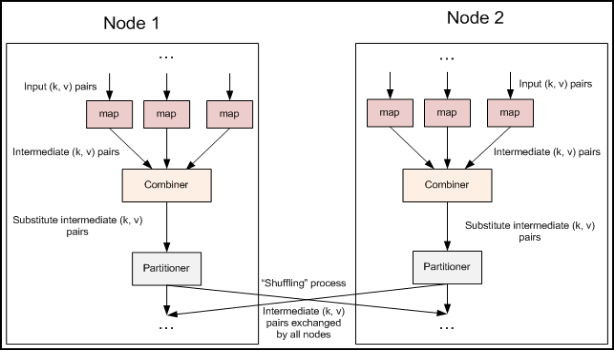我们目前出现的瓶颈问题:
1.如果我们有10亿个数据,Mapper会生成10亿个键值对在网络间进行传输,但如果我们只是对数据求最大值,那么很明显的Mapper只需要输出它所知道的最大值即可。这样做不仅可以减轻网络压力,同样也可以大幅度提高程序效率。
总结:网络带宽严重被占降低程序效率;
2.假设使用美国专利数据集中的国家一项来阐述数据倾斜这个定义,这样的数据远远不是一致性的或者说平衡分布的,由于大多数专利的国家都属于美国,这样不仅Mapper中的键值对、中间阶段(shuffle)的键值对等,大多数的键值对最终会聚集于一个单一的Reducer之上,压倒这个Reducer,从而大大降低程序的性能。
总结:单一节点承载过重降低程序性能;
解决方案:在MapReduce编程模型中,在Mapper和Reducer之间有一个非常重要的组件,它解决了上述的性能瓶颈问题,它就是Combiner。
1.与mapper和reducer不同的是,combiner没有默认的实现,需要显式的设置在conf中才有作用。
2.并不是所有的job都适用combiner,只有操作满足结合律的才可设置combiner。
combine操作类似于:opt(opt(1, 2, 3), opt(4, 5, 6))。如果opt为求和、求最大值的话,可以使用,但是如果是求中值的话,不适用。
MapReduce的一种优化手段:
每一个map都可能会产生大量的本地输出,Combiner的作用就是对map端的输出先做一次合并,以减少在map和reduce节点之间的数据传输量,以提高网络IO性能
作用:
(1)Combiner实现本地key的聚合,对map输出的key排序value进行迭代
如下所示:
map: (K1, V1) → list(K2, V2)
combine: (K2, list(V2)) → list(K2, V2)
reduce: (K2, list(V2)) → list(K3, V3)
(2)Combiner还有本地reduce功能(其本质上就是一个reduce)
例如wordcount的例子和找出value的最大值的程序
combiner和reduce完全一致,如下所示:
map: (K1, V1) → list(K2, V2)
combine: (K2, list(V2)) → list(K3, V3)
reduce: (K3, list(V3)) → list(K4, V4)
使用combiner之后,先完成的map会在本地聚合,提升速度。对于hadoop自带的wordcount的例子,value就是一个叠加的数字,所以map一结束就可以进行reduce的value叠加,而不必要等到所有的map结束再去进行reduce的value叠加。
融合Combiner的MapReduce:

使用MyReducer作为Combiner
job.setCombinerClass(MyReducer.class);
执行后看到map的输出和combine的输入统计是一致的,而combine的输出与reduce的输入统计是一样的。
由此可以看出规约操作成功,而且执行在map的最后,reduce之前。
以数字计数为例:
package mapreduce01;
import java.io.IOException;
import org.apache.hadoop.conf.Configuration;
import org.apache.hadoop.fs.FileSystem;
import org.apache.hadoop.fs.Path;
import org.apache.hadoop.io.IntWritable;
import org.apache.hadoop.io.Text;
import org.apache.hadoop.mapreduce.Job;
import org.apache.hadoop.mapreduce.Mapper;
import org.apache.hadoop.mapreduce.Reducer;
import org.apache.hadoop.mapreduce.lib.input.FileInputFormat;
import org.apache.hadoop.mapreduce.lib.output.FileOutputFormat;
public class test {
static String INPUT_PATH = "hdfs://master:9000/llll";
static String OUTPUT_PATH="hdfs://master:9000/output";
static class MyMapper extends Mapper<Object,Object,Text,IntWritable> {
protected void map(Object key,Object value,Context context)throws IOException, InterruptedException{
String[] arr = value.toString().split(",");
context.write(new Text(arr[0]),new IntWritable(1));
context.write(new Text(arr[1]),new IntWritable(1));
}
}
public static class MyCombiner extends Reducer<Text, IntWritable, Text, IntWritable> {
protected void reduce(Text key, java.lang.Iterable<IntWritable> values,Reducer<Text, IntWritable, Text, IntWritable>.Context context)
throws java.io.IOException, InterruptedException {
int count = 0;
for (IntWritable value : values) {
count += value.get();
}
context.write(key, new IntWritable(count));
};
}
public static void main(String[] args) throws Exception{
Path outputpath=new Path(OUTPUT_PATH);
Configuration conf=new Configuration();
FileSystem fs = outputpath.getFileSystem(conf);
if(fs.exists(outputpath)){
fs.delete(outputpath,true);
}
//wordCount
Job job = Job.getInstance(conf);
FileInputFormat.setInputPaths(job, INPUT_PATH);
FileOutputFormat.setOutputPath(job, outputpath);
job.setMapperClass(MyMapper.class); //map
job.setCombinerClass( MyCombiner.class);
//job.setReducerClass(MyReduce.class); //reduce
job.setOutputKeyClass(Text.class);
job.setOutputValueClass(IntWritable.class);
job.waitForCompletion(true);
}
}
最后可以得出最终的数据。